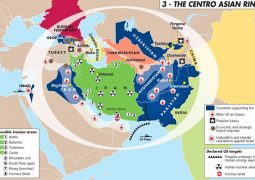India must support Mongolia after China’s crackdown post Dalai Lama’s visit, imposition of toll tax

by Prakash Katosh
Just after the Dalai Lama visited Mongolia in November 2016 for four days, China’s tail caught fire. There was actually no apparent reason for going hyper since this was the ninth visit of Dalai Lama to Mongolia. But then China’s comprehensive national power (CNP) has risen since, even as the economy is slowing down. China perhaps also wanted to signal strong resolve on Tibet to US President-elect Donald Trump, other than the Communist Party of China (CPC) indicating to the Chinese public that it is in total control and can dictate terms to any country. So post the Dalai Lama’s visit to Ulan Bator, China forbade her officials from any interactions with Mongolia. But this is not all: Mongolian trucks crossing into China’s autonomous province of Inner Mongolia are now charged a toll tax of Yuan 10 (Rs 97.9) per truck, and 0.1 percent of the worth of the cargo if it is beyond Yuan 10,000.
Mongolia’s Buddhist population was some 1,459,983 people during the census held in 2010, which was 53 percent of the total population of 2,753,685. As on January 2015, Mongolia’s total population was estimated to be 3,000,251 people. About 59 percent of the total population is below age of 30 years, of which 27 percent are below the age of 14 years. This arbitrary Chinese action of imposing toll tax on Mongolia portrays the pettiness of the CPC; Mongolia being a country with GDP of $11.76 billion (2015 figures) that over the past 20 years has transformed into a vibrant multi-party democracy with booming economy, and is at the threshold of major transformation driven by exploitation of its vast mineral resources as per World Bank. China surely is not in penury to require money from such toll tax variety of ‘sanctions’ but would this be the norm for the much trumpeted one belt, one road (OBOR) project — countries on China’s periphery acquiesce to CPCs diktats or pay toll tax?
Obviously, China decided to “punish” Mongolia in this manner for entertaining the Dalai Lama since Mongolia is landlocked; sandwiched between Russia and China, besides Mongolia being largely dependent on China for transit. In addition, Russia has warmed up to China with the Obama administration having gone all out to ‘squeeze’ Russia in every possible manner, economic sanctions included. Mongolia sought India’s support against China’s obstructionist move, in the backdrop of such arbitrary Chinese action despite Mongolia always supporting China’s ‘One China’ policy. Mongolia till now was dependent on Russian transit rights but China’s imposition of the blockade-like situation will tax the Mongolian economy. India has said it is sympathetic to the problems being faced by Mongolia and will help them utilise the $1 billion financial assistance offered in 2015 during the visit of Prime Minister Narendra Modi to tide over the economic sanctions imposed by China.
As expected China’s Global Post went berserk frothing at the mouth, and in its typically jaundiced language warned Mongolia of dire consequences for seeking financial help from India, dubbing it “politically harebrained”, adding, “Mongolia should be alerted that it cannot afford the risks of such geopolitical games.” But why should be China so mortally scared of the Dalai Lama when she has succeeded in systematic destruction of the Tibetan-Buddhist culture of Tibet and settled seven million Han Chinese in Tibet overwhelming the Tibetans through demographic invasion. There is no insurgency in Tibet — quite opposite to Xinjiang. Tibetan self-immolators in China include teenagers, nuns and monks, majority in China’s Sichuan province, especially around the Kirti Monastery in Ngawa City, Ngawa County, Sichuan, Labran Monastery in Xiahe, and some in Gnasu and Qinghai provinces, besides TAR.
In recent years, CCP’s policy has become harsher against Tibetan monasteries. Many Buddhist monasteries including Dron-na, Tarmoe and Rabten have been forced to shut down in Driru County, Kham Region of eastern Tibet in TAR, where monks have been forced to vacate — all under the garb of CCP’s “patriotic re-education” campaign, even issuing orders for the Chinese flag to be put atop private homes. Some closed monasteries have been converted into prisons and as per reports filtering out despite total clampdown on media and communications in TAR, least details of the cultural genocide gets revealed. There is little chance of Tibetan rebellion overthrowing the Chinese regime in Tibet. So why be scared of the Dalai Lama who has never even talked of independent Tibet? On the other hand, if the west conspires to orchestrate an implosion of China, which may well happen in case the CPC’s aggression crosses western redlines, it is unlikely to centre on Tibet considering the multiple fault-lines that China has.
What China is mortally scared of is a group of any people getting together that may set them thinking in one direction; call it phobia of the CPC devolving around its own insecurity. That is why a simple exercising group like Falun Gong was banned in China. And that is why the atheists of CPC abhor any religion because religion implies gatherings at the place of worship, leave aside gatherings at religious ceremonies and other activities. That is why the clampdown on Buddhists in Tibet, beating of monks and Buddhists gathered to celebrate Dalai Lama’s birthday, and the genocide in Xinjiang. But China makes exceptions in portraying a benign face for religious tolerance where her strategic interests override CPC’s inherent phobias. Prominent example is China’s $3 billion investment in Nepal’s Lumbini project that would help China achieve its long-term strategic goal of bringing Nepal irrevocably under its influence. China has already expanded its railway to Shiatse (Xiagze), seat of Panchan Lama in 2014 in Tibet, which is some 450 kms from Kyirong. By 2020, China plans to extend this rail link to Kyirong which is a mere 26 kms from the Nepal border. Former Nepalese PM Oli during his visit to Beijing in March 2016 had requested China that the Chinese rail link be extended to cross the China-Nepal border. Nepal is also seeking China’s assistance in constructing a monorail in Kathmandu.
The China-Nepal rail line and the Lumbini project is the Nepalese version of the China-Pakistan Economic Corridor. China’s Confucius Institute in Kathmandu University, co-established by Hebei University of Economics and Business, with full support from Office of Chinese Language Council International is spearheading China’s soft power invasion. China is investing in hydropower and tourism development in Nepal. During 2015, Nepal endorsed FDI proposal worth $360 million by China to establish a cement plant in Nepal. This is over and above the numerous ongoing development projects and three star hotels in Kathmandu over past several years manned by PLA disguised as civilians. In recent years, hundreds of Buddhists in Kathmandu have been holding demonstrations to protest authorities stopping them from building a Gompa in the jungles of western Nepal. Ironically, Buddhists make up about 10 percent of the population in Nepal but yet are under severe restrictions because of China’s subjugation of Nepal.
Nepal, under Chinese pressure, stopped issuing refugee identity cards, leaving many Tibetans unable to get higher education or jobs. In recent years, Thinley Lama raising his voice for rights of 20,000 Tibetan refugees in Nepal was put behind bars. Anything Tibetan or Buddhist is anathema to China and the lives of Tibetan refugees in Nepal is turning into hell with Chinese pressure. China is going full hog to crush Tibetan activities in Nepal. Since 2010, Nepal commenced deportation of Tibetans crossing the border — handing them back to Chinese authorities. Nepalese authorities prohibit Tibetan residents from gathering in groups, whether to mark the birthday of the Dalai Lama or just to picnic.
China continues to occupy large parts of Mongolia calling it ‘Inner Mongolia’. In her dream of becoming a ‘Great Power’ on fast track, China’s behavior towards her neighbours can expected to be highly irrational and bullish, with the exception of Pakistan that has surrendered her sovereignty to China. It is only ethical for India to support Mongolia in every possible way including in fields of defence and security.
The author is veteran Lieutenant General of Indian Army
First Published On : Dec 11, 2016 12:05 IST
- Previous Raise voice against China: Mongolia urges India
- Next China’s official media warns Mongolia over seeking Indian help Mongolia caught China by surprise by hosting the Dalai Lama last month for four days











